The one who comes with the intention of performing Hajj either performs Hajj Tamattu’, Qiran, or Ifraad. The one performing tamattu’ leaves his state of Ihram after performing ‘Umrah. Those performing qiran and ifraad continue in their state of Ihram. Actions of Hajj start on the eighth day and continue until the end of the thirteenth day of Dhul-Hijjah. The following are the actions that should be performed by the one making Hajj, taking one day at a time:
1- On the eighth of Dhul-Hijjah, the pilgrim assumes Ihram for Hajj, and it is recommended for him to assume Ihram before dhuhr. He assumes Ihram from the place he is staying, so if he is staying in Makkah, he should assume Ihram there, and if he is in Mina, he should assume Ihram from that area. So he takes the ritual bath, uses perfumes and then wears the Ihram garment. Then he says; “Labbayk Allahumma Hajjan. Labbayk Allahumma labbayk. Labbayka. La shareeka laka. Labbayka. Innal hamda wannihmata laka wal mulk. La shereeka lak.” [ Source: Bukhari.]
2- He heads to Mina and observes Dhuhr, ‘Asr, Maghrib and Isha’ prayers as well as Fajr prayer of the following day, all in Mina, observing each salat at its prescribed time but shortening the four-rakats prayers (to just two). He stays in Mina until sun rise on the 9th day.
It is Sunnah (a recommended or non-obligatory act) to say the Talbiyah several times.
 Ihram
Ihram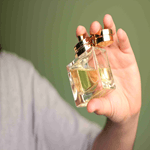 Using perfume
Using perfume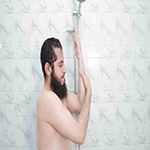 Taking ritual bath
Taking ritual bath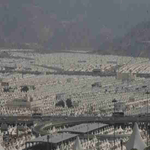 Mina
Mina1-After sunrise, the pilgrim heads to ‘Arafah while saying At- Talbiyah. It is recommended that he goes to Namirah and stays there until the sun starts to pass its meridian, if that is possible for him.
When the sun has passed its meridian and the time of Dhuhr has started, it is a sunnah for the Imam of the Muslims or his deputy to give a khutba to the hojjaj (pilgrims, singular haajj) that fits the occasion, stressing on Tawheed (monotheism) and teaching them the principles of Hajj and the important issues related to their religion.
2-Subsequently the haajj performs Dhuhr and Asr prayers jam’e taqdeem (together in advance) and shortens them. It is prescribed for the haajj on this day to face the qiblah, and supplicate to Allah as much and as diligently as he can. In that supplication he should show his submission to Almighty Allah, as well as his weakness and dire need of Him. He should insist on and persist in repeating supplications. The Prophet ﷺ said: “The best supplication is that done on the Day of Arafat and the best supplication said by me and the prophets before me is: ‘There is no God but Allah alone, He has no partner. To Allah is the dominion, and to Him is all the praise and He is Capable of all things.’” [ Source: Bukhari.] The haajj should be keen to make du’aa using authentically reported supplications, and avoid those which are innovated and factitious. If he reads something from the Qur’an, then this is good, and he should also send his salahs and salams (prayers and salutations) on the Prophet ﷺ.
3-The haajj leaves Arafah for Muzdalifah after sunset, and it is not permissible for him to leave before sunset. If he does leave before sunset, he must return to it, even if it is night-time. If he does not return, he has to make up for this by paying a fedya (ransom) as compensation: a sheep, or a seventh of a camel or (a seventh of) a cow.
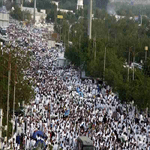 Muzdalifah
Muzdalifah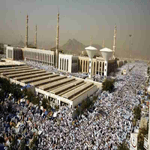 Namirah
Namirah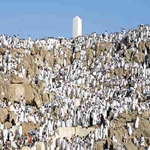 Arafat
ArafatGuidelines :
1- Waqfat ‘Arafat (the standing in Arafat) is realized by the presence of the haajj in ‘Arafah on the ninth day, whether standing, sitting, lying or riding, and it does not mean to be literally standing.
2- Waqfat ‘Arafah is one of the bases of Hajj, without which Hajj is invalid. If the Waqfah is missed, one has missed/avoided all of Hajj; because the Prophet ﷺ said: “Hajj is ‘Arafah.” [ Source: at-Tirmidhi.]
3- The starting time for the waqfah is at dawn of the ninth day and it continues until the dawn of the tenth day. If the haajj is present at ‘Arafah at this time, even for a moment, and he has fulfilled all the conditions of the waqfah, then it is correct. If, on the other hand, he is not present at this time then his Hajj is invalid for what was narrated by Ibn Abbas t in a marfou (elevated) hadeeth : “One who is present in ‘Arafah before Fajr, then his Hajj is fulfilled.” [ Source: Ahmad.]
4- It is permissible to perform the waqfah in any place as long as it is within the area of ‘Arafah. The Prophet stopped at Mount ‘Arafah close to the rocks facing the qiblah, and he did not climb it. He ﷺ said: “I have stopped here, but the whole of ‘Arafah is a stopping place (for the Day of ‘Arafah).” [ Source: Al-Albany (5995) in Sahih Al-Game’.] If it is easy for the haajj to stop at the place where the Messenger of Allah stopped then it is better, otherwise he may perform his waqfah anywhere in ‘Arafah. He cannot, however, stop in the valley before ‘Arafah, named the Valley of ‘Arna, nor climb the mountain, nor climb on the rocks. ‘Arafah has its known boundaries and from the olden times signs have been placed to designate these boundaries. Nowadays new large and very clear ones have been erected, clearly showing the borders from all directions.
5- The haajj has to bear in mind the greatness of this day and its virtue, and that Allah is very generous to His slaves on this day. He boasts about them before His angels, and frees many of His slaves from the Hellfire (on this day). The Prophet (may Allah’s peace and blessings be upon him) said: “There is no day on which Allah frees people from the Hellfire more than on the day of ’Arafah. He comes close to those (people standing on ’Arafah), and then He boasts about them before His angels asking, ‘What are these people seeking?’” [ Source: Muslim.] So the haajj should take this opportunity to make use of every minute of this holy day, and renew repentance and take stock of himself. He should not waste this time in roaming around or in being busy with idle talk and controversies.
1- The haajj leaves ‘Arafah after sunset, heading towards Muzdalifah, and it is a sunnah for the haajj to leave calmly and with dignity so as not to offend people, and to make Talbiyah to Allah Almighty.
2- When the haajj reaches Muzdalifah, he should begin by performing Maghrib and ‘Isha salahs together, shortening ‘Isha salah, before taking his luggage and belongings from the passenger vehicle.
3- The haajj must stay overnight in Muzdalifah this night, and perform Fajr salah early. He must not start moving from Muzdalifah before Fajr except if he has an excuse; such as being a weak woman or young boy, or those accompanying them, or those who serve the hojjaj. It is permissible for these to leave Muzdalifah at the end of the night when the moon sets.
4- After the haajj performs Fajr it is desirable that he comes to the Mish’ar Haraam (sacred site or monument) and, facing qiblah, make much dhikr (remembrance) of Allah, Takbeer and supplications, raising his hands up in a sincere manner, beseeching Allah. The haajj should continue to do this until the sun shines, and anywhere he stops to do that in Muzdalifah is acceptable, for the saying of the Prophet (may the peace and blessing of Allah be upon him): “…and I stopped here and anywhere in (the area of) Jama’ it is permissible to stop.” [ Source: Muslim.] What is meant by Jama’ is Muzdalifah.
5- When a haajj leaves Muzdalifah, he is advised to pick up seven pebbles to throw at the jamaraat of the first day, only, while the rest of the days he takes their pepples from Mina. It is permissible, however, to pick up pebbles from anywhere.
1- He observes Fajr prayer and thereafter engages in supplications and invocations until close to sunrise.
2- The haajj leaves Muzdalifah before sunrise on his way to Mina. He should make much Talbiyah on the way. When he reaches the valley of Mohser, which is a valley before Mina, between Mina and Muzdalifah, he should move faster. When he reaches Mina, he carries out the actions of the ‘Eid day, which are in brief: stoning of Jamratul Aqabah, slaughtering an animal, shaving or trimming the hair, Tawaaf, and Sa’y.
3- When he arrives at Mina he goes to Jamratul ‘Aqabah, which is the furthest Jamrah from the centre of Mina and the nearest one to Makkah. So when he reaches it, he stops saying Talbiyah and stones the Jamrah with seven pebbles, one after the other, saying “Allahu Akbar” with every throw.
The desirable time for stoning starts at Fajr, the day of ‘Eid, but it is correct and acceptable to stone before Fajr, at the end of the night. The stoning time continues until Fajr on the eleventh day.
- A Muslim should avoid harming his hojjaj brothers when throwing the jamaraat and during the performance of the rest of the Hajj rites.
- The haajj must make sure that the pebbles he throws fall into the basin, for some people make a mistake and think that the stoning should be aimed at the pillar, and then the pebbles do not fall into the basin. Others aim from a distance and so the pebbles also do not fall into the basin. Such people do not perform the duty of stoning.
- If the haajj throws all the pebbles at once, it does not count as anything for him except one pebble, and if he just places the pebbles in the basin, this is also invalid, for stoning must take place.
4- Men shave their heads or cut their hair from all sides, but shaving is better. Women, however, only cut as much as an inch from the hair on their heads.
5- The haajj then leaves for Makkah to perform Tawaaf Ifadah (tawaaf of pouring forth) which is the final obligatory circumambulation of the Ka`bah in Hajj, in which there is neither Ramal (rapid ritual walk for men) nor Idtiba’ (having the right shoulder exposed). After Tawaaf he prays two Rik’as and the best way to perform this tawaaf is to first take off his ihram clothing, after stoning and shaving, and wear his ordinary clothes and put on perfume. Aisha (may Allah be pleased with her) said: “I used to perfume the Messenger of Allah ﷺ when he was entering into the state of ihram and when he was leaving the state of ihram before making Tawaaf of the House (i.e. The Ka’ba).” [Agreed upon.]
6- The time to perform Tawaaf begins after Fajr on the day of ‘Eid, and it is acceptable to perform it before Fajr, at the end of the eve of ‘Eid, for the weak who hastened from Muzdalifah. The haajj may delay Tawaaf to after the ‘Eid day, but this disagrees with what is best.
7-After Tawaaf Ifaadah it is necessary for the haajj who is performong Hajj Tamattu’ to make Sa’y between Safa and Marwa. Those hojjaj performing Hajj Ifraad and Qiran, however, if they have performed Sa’y after Tawaaf Qodoom (of arrival), then they do not have to perform Sa’y after Tawaaf Al-Ifadaah. When the haajj has finished performing Tawaaf Ifadah and Sa’y – if he had to perform Sa’y – he has finished all the actions of the ‘Eid day, so he has to return to Mina to stay there the eve of the eleventh of Dhul-Hijjah.
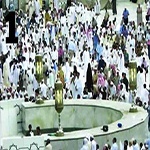 Stoning the Jamrah
Stoning the Jamrah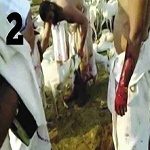 Slaughtering the animal offering
Slaughtering the animal offering.jpg) Shaving and trimming the hair
Shaving and trimming the hair.jpg) Circumambulation (Tawaaf)
Circumambulation (Tawaaf)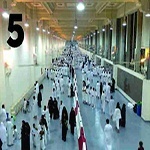 As-Sa’y between as-Safa and al-Marwa
As-Sa’y between as-Safa and al-Marwa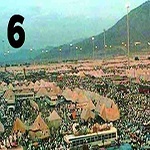 Spending the night in Mina
Spending the night in MinaThe sunnah is to arrange the ‘Eid day actions as follows: First stoning, then slaughtering an animal, following that is the shaving of hair, then Tawaaf, and then lastly Sa’y for those who have to perform Sa’y. If however one action is performed before the other, it is still acceptable: because the Prophet allowed that. If he, thus, shaves first and then stones, it is acceptable. If he slaughters first and then makes Tawaaf and then stones, it is also acceptable, and so on. This is because the Prophet was asked about doing actions before others on this day and he replied: “Do that, (there is) no harm (in it).” [ Agreed upon.]
The first and the second phases of disengagement (freedom from prohibitions of Ihram)..
- First Tahallul (leaving the state of Ihram): The haajj is allowed to do all that he had been prohibited from doing due to the fact of him being in the state of Ihram, except having intercourse with his wife as well as any actions that might lead to that, and also arranging any marriage. These actions are not permissible for him. He is allowed to perform his first Tahallul after doing any two of the following: Stoning Jamarat al-Aqaba, shaving his hair or having a haircut, or Tawaaf with Sa’y for those who have to make Sa’y.
- Second Tahallul: Everything that was prohibited for the haajj, because of him being in a state of Ihram, is now allowed. The second Tahallul takes place after doing all of the acts previously mentioned for the first Tahallul.
Slaughtering an animal has nothing to do with Tahallul. Thus, if the haajj delays the sacrifice of his animal to the eleventh day, and then carries on with the other actions of ‘Eid day, he could then perform Tahallul even if he has not slaughtered an animal yet.
They are three days: The eleventh, twelfth, and thirteenth of the month of Dhul-Hijjah, so named because sacrificial meat used to be dehydrated (tosharraq) in these days, i.e. cut, sliced, and dried in the sun.
The Messenger of Allah said: “Truly these days are days of eating, drinking and remembrance of Allah Almighty.” [ Source: Abu Dawud.]
The haajj must stay overnight in Mina on the eve of the eleventh. On the eleventh day, after the sun moves from its meridian, the haajj stones the three jamarat, each one with seven pebbles.[ They are three basins, in each there is a fixed stony pillar. They are positioned on the edge of Mina, near to Makkah The first pillar is al-Jamratus-sughra, then al-Jamratu al-wusta , then Jamratu al-aqabah (or the bigger stone). It is on the boundary of Mina, from the side of Makkah.]
Method of stoning the Jamarat ..
The haajj begins with the first Jamrah: He stones it with seven pebbles, one after the other, and makes Takbeer with each pebble. The pebbles should all fall in the basin. Subsequently the haajj advances a little further and stands to supplicate to Allah with raised hands.
Following that comes the central Jamrah: he stones that with seven pebbles, as he had done with the first, and then supplicates with raised hands.
Lastly the Jamaratul Aqabah: He stones that with seven pebbles, but does not stop to supplicate here.
_(Jamratul Uulaa).jpg) The first Jamrah (stone pillars) (Jamratul Uulaa)
The first Jamrah (stone pillars) (Jamratul Uulaa)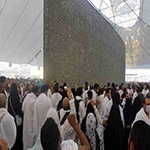 The last Jamrah (Jamratul ‘aqabah)
The last Jamrah (Jamratul ‘aqabah)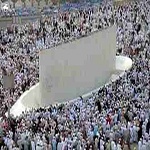 The middle Jamrah (Jamratul wustaa)
The middle Jamrah (Jamratul wustaa)The haajj must stay overnight in Mina on the eve of the twelfth. Subsequently, when the sun moves down from its meridian, he stones the three Jamarat exactly as he did on the eleventh day.
If he wants to hasten to leave on this day, he stones and then leaves Mina before sunset. If the sun sets and he has not yet left Mina, he has to stay overnight and perform the stoning ritual again on the thirteenth day, which is a way to receive extra rewards. Allah says: “But whosoever hastens to leave in two days, there is no sin on him, and whosoever stays on, there is no sin on him, if his aim is to do good and obey Allah (fear Him)” (Al-Baqarah: 203): This refers to one hastening and leaving after two days of the days of Tashreeq, which are the eleventh and twelfth, or delaying to complete the thirteenth day.
After the sun moves down from its meridian on the thirteenth day, the haajj stones the three Jamaraat as previously completed on the eleventh day, and the time for stoning ends at sunset that day.
It is permissible for the haajj to delay the stoning of the Jamarat of one day to the next one, and to delay that to the last day since all days of Tashreeq are days for stoning Jamarat.
He must then start stoning the three Jamarat for the first day he has delayed. He then returns to the smallest (first) Jamarah and stones it for the next day he has delayed and so on. This he should do after the sun moves down from its meridian.
When the haajj wants to leave Makkah, he should make Tawaaf Al-Wada’ (farwell circumambulation), which is one of the obligatory actions of Hajj. There is no Sa’y after that Tawaaf and women who have their menstruation or postpartum period must not perform Tawaaf Al-Wada’.
It is permissible for a haajj to delay the Tawaaf Ifadah to the time of Tawaaf Al-Wada’, though this is not according to the best opinion. It is acceptable for him to perform the Tawaaf Al-Ifadah in place of Tawaaf Al-Wada’ on condition that his niyya is to perform Tawaaf Al-Ifadah, and it suffices him even if he performs sa’y after that.
The wisdom behind performing Tawaaf, Sa’y and stoning is to perform dhikr (remembrance) of Allah.
1- When the pilgrim intending ‘Umrah arrives at the Meeqaat, he takes the ritual bath, applies scent and then puts on the Ihram garment. Then he makes the intention for ‘Umrah by saying; “Labbayka ‘Umrah”.
2- He proceeds, saying the Talbiyah; “Labbayka Allahumma labbayka. Labbayka la shareeka Laka labbayka. Innal hamda wan ni’mata Laka wal Mulk, la shareeka Lak.” [ Source: Bukhari.] He continues to say the Talbiyah until he sees the House (the Ka’bah) and reaches the Black Stone.
3- He enters the Haram Mosque, starting with his right foot and saying the supplication for entering the Mosque.
4- He terminates his talbiyah and starts circumambulating the House, beginning from the Black Stone by touching and kissing it - if possible - otherwise he just points to it.
5- He puts the House to his left and circumambulates seven times completely, starting from the Black Stone and ending with it.
6- It is sunnah to perform Ramal in the first three rounds, which is to walk quickly with short steps without bouncing. It is also sunnah to perform Idtiba’ while he is making Tawaaf and that is by exposing his right arm, putting his garment underneath it and placing the tail of the garment on his left shoulder.
7- He supplicates during the circumambulation as he desires. When he is aligned with the Yemeni corner, he touches it and says “Allahu akbar”, and if he is not able to touch it, he does not point at it or say “Allahu Akbar”. When between the Yemeni corner and the Black Stone, he says: “Rabbanaa aatina fid dunya hasanatan wa fil aakhirati hasanatan wa qina athaban naar.” [ Source : Abu Dawud.] Meaning: Our Lord! Give us in this world that which is good and in the Hereafter that which is good, and save us from the torment of the fire.
8- When he completes the seventh round, he covers both his shoulders with his garment and leaves idtibaa’ (i.e exposing the right shoulder); because idtibaa’ is not a sunnah except in the tawaaf of ‘Umrah or the tawaaf al-Qodoom.
Following that he goes to Maqaamu Ibrahim (peace be upon him), if that is possible, and performs two raka’at behind it in which he reads Surat (al-Kafiroun) after al-Fatiha in the first rak’ah, and in the second (al-Ikhlass). If, however, it is not possible to perform the two raka’at behind al-Maqaam, he can do that wherever he wants.
9- He leaves to as-Safa and when he is almost there, he recites the statement of Allah, the Most High; “Innas Safa wal Marwata min Sha’aa’irillaah. Fa man Hajja bayta awi’tamara, Falaa junaaha alayhi ayyasawwafa bihima wa man tatawwa’a khayran fa innallaha Shaakirun ‘Aleem” Meaning: “Verily as-Safa and al-Marwah (two mountains in Makkah) are of the symbols of Allah. So it is not a sin on him who performs Hajj or ‘Umrah (pilgrimage) of the House to stroll between them. And who ever does good voluntarily, then verily Allah is The All-Recognizer, All-Knower” (al-Baqara; 158).
10- He ascends as-Safa and faces the Qiblah raising his hands to magnify and praise Allah, and saying: [ Source : Abu Dawud.] meaning: “There is no God but Allah, alone, He has no partner, His is the dominion and praise and He is able to do all things. There is no God but Allah, alone. Allah fulfilled His promise, and He made His slave victorious, and He alone destroyed the confederates.”
Thereafter he invokes Allah, and repeats this supplication three times. It is also mentioned in the hadeeth that “he does like he had done on as-Safa.” [ Source: Bukhari.]
11- He descends from as-Safa facing al-Marwa, he hastens in his walking between the two green flags[ Both are two signs to mark the place where Hajar started to run quickly in her Sa’y between as-Safa and al-Marwa...], then he ascends al-Marwa and he does like he had done on as-Safa.
12- He circuits between as-Safa and al-Marwa seven times.
(Going is one round and returning is another round)
- It is a sunnah while performing Sa’y to be in a state of purity. If, however, he performs Sa’y while not in a state of purity, his Sa’y is still correct. It is also a sunnah to perform Tawaaf and Sa’y consecutively.
13- After the Sa’y, male pilgrims cut their hair so short as to be clearly noticeable. However the women shorten their hair at the tips to the length of only an inch.
The best for men however is to shave the hair on their heads according to what is confirmed on the authority of Abu Hurairah t: The Messenger of Allah ﷺ said: “O my Lord, forgive those that shave their heads, so they asked: “And those that (only) cut their hair?” He said: “O my Lord, forgive those who shave their heads.” They asked again: “And those that (only) cut their hair?” … He said this (du’a) three times, and finally said: “And those that (only) cut their hair.” [ Source: Bukhari.]
If he is performing Hajj Tamattu’ and is joining ‘Umrah with Haj,j, and there is not enough time for his hair to grow long, then shortening his hair is better, and he delays shaving it until Hajj.
14- He releases himself from his Ihram, and with that he completes his ‘Umrah.
Women do the same as men in Tawaaf and Sa’y, except that she does not perform Ramal in Tawaaf, and she does not quicken here steps in her Sa’y between the two green flags. She also should not shave her head, but only shorten, from all her hair, as much as an inch, which is as long as the upper finger joint.
1- A Muslim should not crowd towards others who are performing Tawaaf and he should not make it difficult for himself and others in order to touch or kiss the Black Stone. He should also not perform Ramal if he will harm others performing Tawaaf with his Ramal.
2- He supplicates in Tawaaf with whatever is possible. There are no special supplications for Tawaaf, except what was previously mentioned. It is acceptable to recite from the Qur’an while performing Tawaaf.
3- Idtiba’ is a sunnah in Tawaaf of ‘Umrah or Tawaaful-Qodoom in all the rounds of Tawaaf.
4- When performing circumambulation, women should avoid displaying their adornments, being perfumed, and raising their voices with dhikr and du’aa.